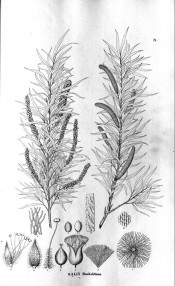Salix chilensis Molina var. fastigiata
The species is a small, deciduous tree, to 10m. Crown conical or spreading; branches long, drooping. Trunk often bent, 12 inches or more in diameter, and unbranched for 6m. Bark reddish or dark brown with a grayish tinge, fairly smooth or with long, coarse fissures ; inner bark fibrous and is used for cordage. Leaves lanceolate; foliage much lighter and brighter green than is usual in tropical trees. [Williams – Fieldiana, Botany series vol.15, Woods of Northeastern Peru p.68/1936]. The variety fastigiata is an upright tree with a narrow, elongated habit, similar to the Lombardy poplar.
Horticultural & Botanical History
Figured in Flora Brasiliensis as Salix humboldtiana [Martius - Flora Brasiliensis vol.4, pt.1, t.71/1840-1906].
Introduced to Britain in 1823. [PD]. At one time a common decorative tree.
History at Camden Park
Listed only in the 1857 catalogue [T.918/1857].
Notes
A weed in parts of Queensland.
Published Mar 26, 2010 - 04:51 PM | Last updated Aug 13, 2010 - 01:28 PM
| Family | Salicaceae |
|---|---|
| Category | |
| Region of origin | Chile |
| Synonyms |
|
| Common Name | Pencil willow |
| Name in the Camden Park Record |
Salix fastigiata |
| Confidence level | high |
